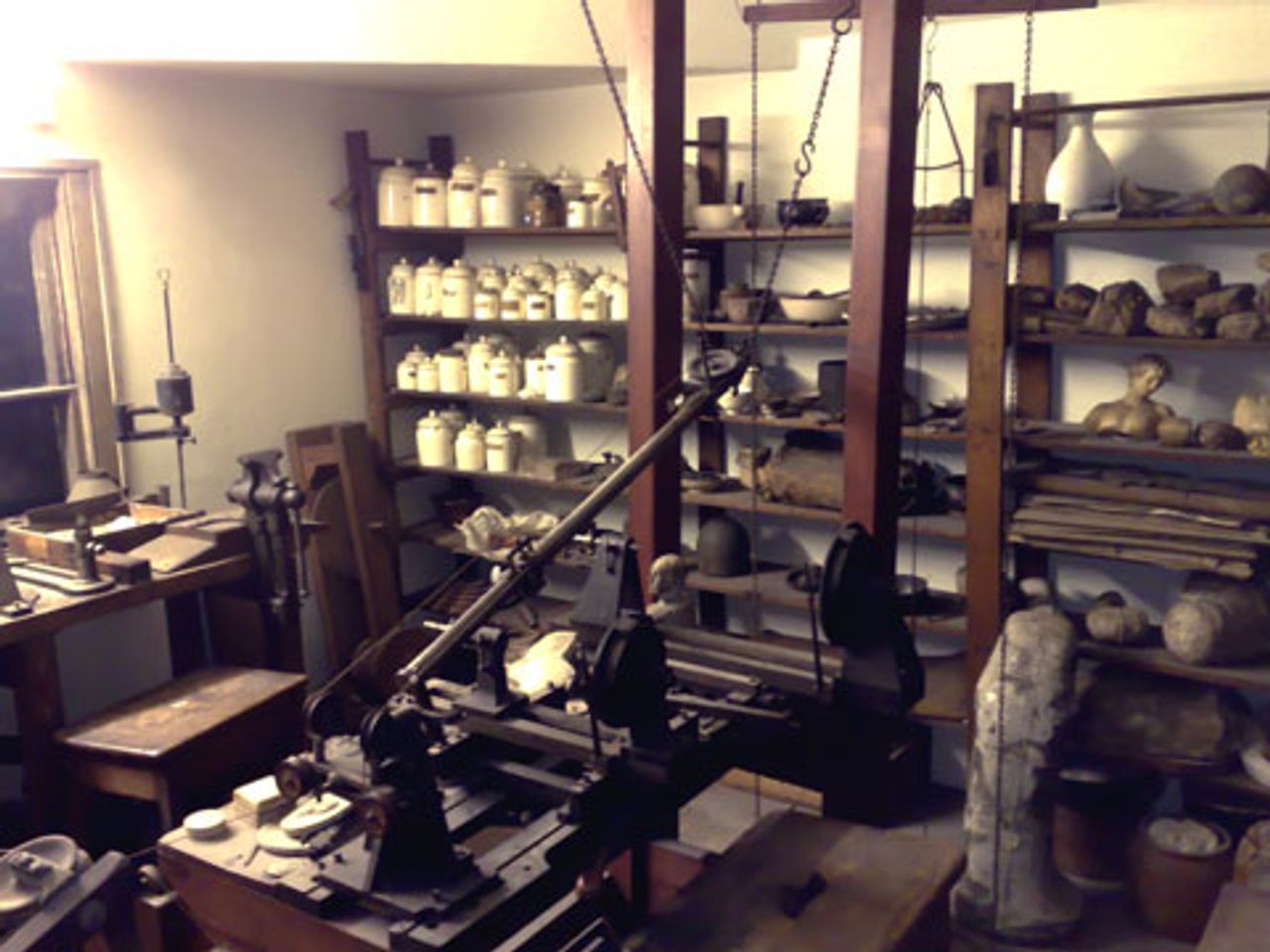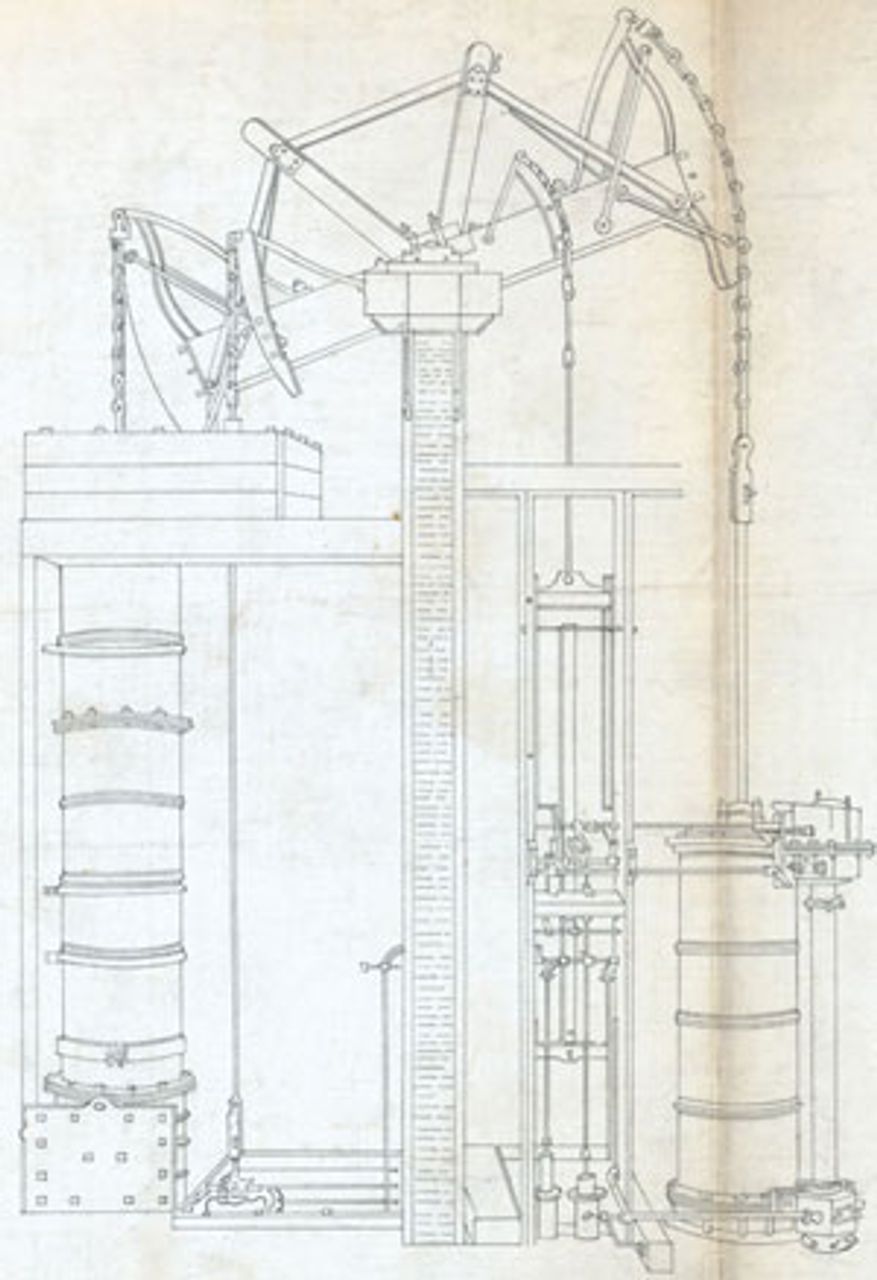Anyone with an hour or two to spare in London over the next year will be rewarded by a visit to the James Watt exhibition at the Science Museum.[1] As befits an exhibition relating to this genius whose inventions were at the core of the Industrial Revolution, there are several steam engines on display, including the massive “Old Bess,” the second steam engine built by James Watt and his partner Matthew Boulton in their Birmingham “Manufactory,” in 1777.
 James Watt’s garret workshop
James Watt’s garret workshopPride of place in the exhibition however is Watt’s workshop, reassembled exactly as he had left it in his Birmingham house when he died in 1819. Containing 8,430 objects, which are shown in turn in a slideshow projected on screens next to the workshop itself, it gives a fascinating vision of the vast range of investigations, inventions, and interests that made up Watt’s life.
It includes pieces of flutes and violins—Watt was at one time a maker of musical instruments as well as scientific instruments. There is a roller press, a machine invented by Watt for copying letters, forerunner of our photocopier. Also on display are circular saws designed by Watt. There is a machine that mills miniature copies of sculptures in three dimensions, some of which are on display. Mixed in with a vast variety of tools, including a lathe, is a device to record the pressure of boilers graphically, and a counting machine to work out customers’ bills. A collection of pottery jars was left, presumably undergoing tests that Watt was known to carry out. Here was a man whose interests were clearly not limited to steam engines but encompassed the entire range of technology of the day and extended to the arts and sciences.
Only a brief reference is made in the exhibition to the fact that Watt belonged to what was known as the Lunar Society, the small group of natural philosophers, scientists, industrialists and intellectuals that met regularly for informal discussion and dinner in Birmingham during the second half of the eighteenth century. It was one of the main expressions of the Enlightenment in Britain and included, besides Boulton and Watt, the medical doctor and poet Erasmus Darwin, grandfather of Charles Darwin; the manufacturer of pottery Josiah Wedgwood; and the dissenting clergyman, materialist and chemist Joseph Priestley. They were passionately interested in all branches of science but also the latest in technology and aesthetics, history, the arts and politics. They have rightly been seen as the fathers of the Industrial Revolution.
The Lunar Society men had a variety of backgrounds. Boulton had left school at 14, Darwin was highly educated at Cambridge and Edinburgh universities. Many of them were connected to the dissenting academies that had recently been set up and became centres of the new learning.
Politically, they campaigned for the abolition of slavery and for a variety of reforms, including the repeal of the Test Acts, the law that prevented religious dissenters—which many of them were—from entering university of holding public office. All of them supported the French Revolution. They were the leaders of the most radical and far-sighted sections of the bourgeoisie in that period, and Watt can only be understood in that context.[2]
Born in 1736, Watt worked as a young man as a brilliant instrument maker producing and repairing astronomical and other scientific equipment at the University of Glasgow. He had no formal qualifications or apprenticeship. At the university, he became interested in steam engines, which at that time meant the Newcomen engines used for pumping water out of coal, tin, copper and lead mines. These engines relied on steam being condensed in a cylinder by an injected stream of cold water, so that the partial vacuum created pulled down a piston. The piston was connected via a beam to a pump at the bottom of the mineshaft. Watt’s investigations showed that because in each stroke of the pump the cylinder was cooled down by the injected water, about 80 percent of the heat in the steam was used up in reheating the cylinder.
 “Old Bess”
“Old Bess”Watt’s innovation was to create a separate chamber, a condenser, so that the steam could be condensed away from the cylinder, enabling it to be kept hot and obviating the need for the continuous and very inefficient reheating. By 1765, Watt had constructed a working model of his new and much more efficient type of engine. The original model condenser was recently discovered on a bench in Watt’s workshop and is now one of the items on display.
It is commonly suggested by historians that the technological developments of the Industrial Revolution did not depend on the developments in science or on the seventeenth and eighteenth century Enlightenment. Only after the development of steam power, it is claimed, did the science of thermodynamics develop in a study of engines by such nineteenth century scientists as Nicolas Léonard Sadi Carnot in France.
In the nineteenth century, it was true that the capitalist class in Britain, the dominant industrial power, could advance with crude empiricism and disdain for theory, but it was certainly not characteristic of James Watt in this earlier period. Watt developed his engine on the basis of a scientific investigation of the properties of steam, including realising the importance of latent heat—the extra heat that is needed to convert water at boiling point into steam. He worked with Joseph Black, professor of chemistry at Glasgow University, the discoverer of carbon dioxide. Black was the first to discover latent heat and began the process of turning the study of heat into an exact science, working out specific heats and measuring thermal expansion. He was a friend of Adam Smith and David Hume and very much a part of the Scottish Enlightenment.
Watt shared Black’s wide scientific interests. Among the objects on display in Watt’s workshop are jars of chemicals, including those used for dyeing, and models of crystals that represented the minerals investigated in the emerging science of geology. As the historian Raymond Birn explains, “Black was keen to emphasise the interdependence of theoretical science and applied technology, a departure from common practice”.[3] Black and Watt became friends, and Black not only encouraged Watt to overcome the problems of the Newcomen engine, but also gave him theoretical guidance and put up some of the money required for the construction of a full-scale engine.
Watt was also backed by another innovator, Dr. John Roebuck, the owner of Scotland’s Carron Iron Works, which was to become a world leader. Eventually, Watt teamed up with Matthew Boulton in Birmingham, who bought out Roebuck’s patent rights and obtained help in overcoming the problem of boring a cylinder with a tight-fitting piston. This was achieved by using the skills of one of the greatest iron masters of the day, John “Iron Mad” Wilkinson, who owned a foundry at nearby Wrexham. He was the brother-in-law of Joseph Priestley.
By 1776, the first engines were built and made to work. With a series of additional inventions and improvements, they were used not only for pumping out mines, but in providing rotational power used in weaving, grinding and milling that were crucial to the Industrial Revolution. By 1824, the company set up by Boulton and Watt had produced 1,164 steam engines.
Perhaps the greatest tribute to Watt, and by implication to Boulton, comes from Karl Marx in Chapter 15 of the first volume of Capital, in which he explains the economic importance of machinery compared to previous means of production.
Developed machinery consists of the motor or prime mover, the transmitting mechanism—gears, pulleys, etc.—and the tool or working machine. In the latter, Marx writes, “we rediscover in it, as a general rule, though often in highly modified forms, the very apparatus and tools used by the handicraftsman or manufacturing worker; but there is the difference that instead of being the tools of man they are the implements of a mechanism, mechanical instruments”.[4] It is the machine that is able to bring into play many tools at once that gave rise to the industrial revolution and enabled the capitalist class to extract surplus value on a more massive scale than ever before. The large-scale use of machines demanded a more efficient source of motive power.
“The steam engine itself,” Marx writes, “such as it was at its invention during the manufacturing period at the close of the seventeenth century, and as such continued to be down to 1780, did not give rise to any industrial revolution. It was, on the contrary, the invention of machines that made a revolution in the form of steam engines necessary.”
The importance of Watt’s steam engine was in providing a prime mover that was entirely under the control of human beings, unlike water power, which varied with the seasons and weather. Production was no longer sporadic and scattered. A steam engine could work round the clock in all seasons. It allowed industry to become concentrated in towns and an entirely new kind of city to emerge, typified by Manchester as Engels first encountered it as young man. The industrial town gathered together many thousands of workers in one place and became the crucible in which a new class came into being.
Marx wrote, “The greatness of Watt’s genius showed itself in the specification of the patent that he took out in April 1784. In that specification his steam engine is described, not as an invention for a specific purpose, but as an agent universally applicable in industry. Many of the applications he points out in it, for instance the steam-hammer, were not introduced until half a century later. Even so he doubted the applicability of steam to navigation. Yet steam engines of colossal size for ocean steamers were sent to the Great Exhibition of 1851 by his successors, the firm of Boulton and Watt.”
[1] http://www.sciencemuseum.org.uk/watt
[2] For more details see Jenny Uglow, The Lunar Men (Faber and Faber, 2002) and
http://www.oxforddnb.com/public/themes/59/59220.html
[3] Raymond Birn, Crisis, Absolutism, Revolution: Europe and the World, 1648-1789 (Broadview, 2005).
[4] Karl Marx, Capital, Volume 1 (Penguin 1976).
